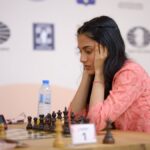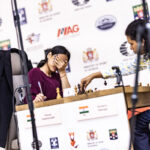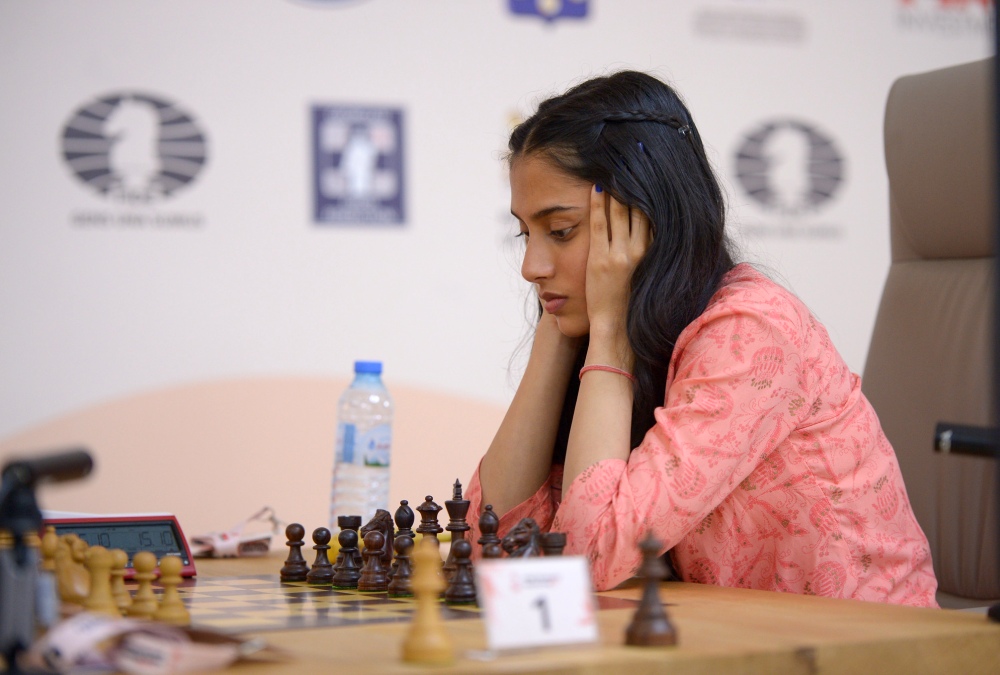Divya Deshmukh Claims Historic Women’s World Cup Championship Victory Over Humpy Koneru
Breaking Chess History: 19-Year-Old Indian Prodigy Conquers Women’s World Cup
Divya Deshmukh Claims Historic Women’s World Cup: Divya Deshmukh has achieved what many considered impossible at just 19 years of age. The International Master from Nagpur, Maharashtra, has captured the prestigious Women’s World Cup title after a thrilling tiebreak victory against seasoned Grandmaster Humpy Koneru. This monumental achievement places her among the elite trio of Women’s World Cup champions, following Alexandra Kosteniuk (2021) and Aleksandra Goryachkina (2023).
We witnessed chess history unfold in Batumi, Georgia, as Deshmukh’s remarkable journey culminated in a 1.5-0.5 tiebreak triumph that showcased both tactical brilliance and mental fortitude under extreme pressure. The victory not only secured the $50,000 first prize but also automatically earned her the coveted Grandmaster title—a rare achievement accomplished through winning a major FIDE event rather than the traditional three GM norms and 2500 rating requirement.
Strategic Masterclass: Analyzing the Championship Tiebreak Games
First Tiebreak Game: Missed Opportunities and Defensive Resilience
The opening tiebreak game demonstrated the razor-thin margins that separate victory from defeat at the highest level of competitive chess. Playing with the white pieces, Deshmukh opened with 1.e4, prompting an unexpected response from Koneru who deviated from her usual 2…Nc6 systems to employ the Petroff Defence (2…Nf6).
This strategic choice revealed Koneru’s preparation depth, as she had largely abandoned the Petroff in favor of the ultra-solid Berlin Defence since late 2023. Her decision to return to this opening with the specific 6…Bf5 variation—previously used successfully against Deshmukh in the Tata Steel India Blitz 2023—demonstrated sophisticated psychological warfare at the board.
The game followed established theory until move 15, mirroring the Leon Luke Mendonca versus Arseniy Nesterov encounter from the 2024 Biel Masters. Deshmukh’s bold 20.d5 pawn break aimed to liquidate her isolated queen’s pawn while opening lines for her active minor pieces. Koneru’s immediate 20…Rad8 response showed tactical awareness, targeting the newly weakened central squares.
The critical moment arrived when time pressure forced Koneru into 33…Re7, overlooking a devastating tactical sequence. Deshmukh’s precise 34.Rd1 created multiple threats, forcing Koneru into a queen sacrifice that led to a complex rook, bishop, and pawn versus queen endgame. Despite the material imbalance, Koneru constructed a defensive fortress that ultimately held for a draw.
Second Tiebreak Game: Time Pressure and Championship Determination
The decisive second game showcased why rapid chess often produces the most dramatic conclusions in tournament play. Koneru’s choice of the Catalan Opening met with Deshmukh’s aggressive 4…dxc4, 5…Bb4+ variation—a system gaining popularity among elite players including Dmitry Andreikin, Grigoriy Oparin, and Parham Maghsoodloo.
This opening choice represented calculated risk-taking from Deshmukh, accepting a pawn sacrifice in exchange for development lag and dark-square weaknesses. Modern theoretical understanding suggests that accurate pawn timing can lead to defensible or equal endgames, but the practical challenges remain significant under tournament conditions.
Time management became the decisive factor as Koneru found herself with under three minutes compared to Deshmukh’s eleven-minute advantage. The position remained balanced through careful maneuvering until Koneru’s nerve-induced 40.e4 central break, followed immediately by the blunder 41.d5.
Deshmukh’s immediate 41…Qe5 response seized control of the position, leading to a tense rook endgame where her 53…f4 pawn sacrifice activated her king position. Despite mutual time pressure and technical imprecision from both players, Deshmukh’s superior time management and endgame technique secured the championship victory.
Path to Grandmaster: Achievement Through Excellence
Deshmukh’s automatic Grandmaster title achievement represents one of the rarest paths to chess’s highest honor. Rather than accumulating three GM norms and achieving a 2500 rating through conventional tournament play, she earned the title by winning a major FIDE championship event—a distinction shared by very few players in chess history.
We observed her emotional response to this achievement: “I still need time to process it. I think it was fate, me getting the Grandmaster title this way, because before this I didn’t even have one norm, and now I’m a Grandmaster.” This statement underscores the extraordinary nature of her accomplishment, bypassing traditional advancement pathways through sheer championship excellence.
Tournament Structure and Global Competition
The 2025 FIDE Women’s World Cup established new standards for women’s competitive chess, attracting 107 players from 46 different federations. The tournament featured seventeen of the current top-twenty rated female players, creating an unprecedented depth of competition throughout all elimination rounds.
We witnessed three weeks of intensive competition from July 6th to July 28th in Batumi, Georgia, where chess legends, seasoned professionals, and emerging talents competed for the substantial $50,000 first prize and three qualifying positions for the Candidates Tournament.
graph LR
A[107 Players from 46 Federations] --> B[Elimination Rounds]
B --> C[Semifinal: Deshmukh vs Player X]
B --> D[Semifinal: Koneru vs Player Y]
C --> E[Final: Deshmukh vs Koneru]
D --> E
E --> F[Tiebreak Game 1: Draw]
E --> G[Tiebreak Game 2: Deshmukh Wins]
G --> H[Championship Victory]
H --> I[Automatic GM Title]
H --> J[Candidates Qualification]
H --> K[$50,000 Prize]
Future Implications: Candidates Tournament and Beyond
Deshmukh’s victory automatically qualifies her for the 2026 Candidates Tournament, joining fellow qualifiers Humpy Koneru (second place) and former Women’s World Champion Tan Zhongyi (third place). This qualification represents another milestone in her rapidly accelerating career trajectory.
We anticipate significant impact on women’s chess development, particularly in India where Deshmukh joins a growing cohort of elite female players challenging for global supremacy. Her achievement at age 19 suggests sustained excellence potential over the coming decades of competitive play.
Technical Analysis: Opening Repertoire and Strategic Development
Deshmukh’s championship run demonstrated sophisticated opening preparation across multiple systems. Her willingness to employ aggressive variations like the 4…dxc4, 5…Bb4+ Catalan system reveals deep theoretical understanding combined with practical fighting spirit.
We observed consistent tactical alertness throughout the tournament, particularly evident in her 34.Rd1 breakthrough in the first tiebreak game. Her ability to identify and execute complex tactical sequences under time pressure indicates the pattern recognition skills essential for sustained elite performance.
The championship games revealed areas for continued development, particularly in endgame technique. Deshmukh’s honest self-assessment—”I definitely need to learn endgames. I’m pretty sure I messed up the ending at some point”—demonstrates the self-awareness crucial for continued improvement at the highest competitive levels.
Historical Context: Third Women’s World Cup Champion
Deshmukh’s achievement places her in exclusive company with Alexandra Kosteniuk (2021) and Aleksandra Goryachkina (2023) as the tournament’s only champions since its establishment. Each victory has contributed to the growing prestige and competitive significance of the Women’s World Cup within the global chess calendar.
We recognize this championship as validation of the tournament format’s success in identifying and rewarding the world’s strongest female players. The combination of knockout elimination pressure and rapid time controls creates conditions that test both technical skill and psychological resilience.
Post-Championship Perspective and Legacy Building
Deshmukh’s immediate post-victory comments revealed maturity beyond her years: “It’s hard for me to speak now. Of course, this definitely means a lot, but there is a lot more to achieve, so I am hoping that this is just the start.” This perspective suggests understanding that championship victories, while significant, represent stepping stones rather than ultimate destinations.
We expect continued development as she transitions from promising talent to established elite player. Her automatic Grandmaster status and Candidates qualification provide platforms for sustained high-level competition against the world’s strongest female players.
The championship victory establishes Deshmukh as a legitimate contender for future Women’s World Championship cycles, adding depth to an increasingly competitive field of elite female players challenging for chess’s ultimate prize.
Conclusion: A New Era in Women’s Chess
Divya Deshmukh’s Women’s World Cup championship victory represents more than individual achievement—it signals the emergence of a new generation of elite female players capable of combining theoretical preparation, tactical execution, and psychological resilience under the highest competitive pressure.
We witnessed the convergence of talent, preparation, and opportunity that defines championship excellence. Her victory over the experienced Grandmaster Humpy Koneru demonstrated that age and experience, while valuable, cannot substitute for preparation, determination, and execution when the stakes are highest.
The automatic Grandmaster title and Candidates Tournament qualification position Deshmukh for continued success at the elite level, while her championship victory inspires the next generation of female chess players pursuing excellence in competitive play.













